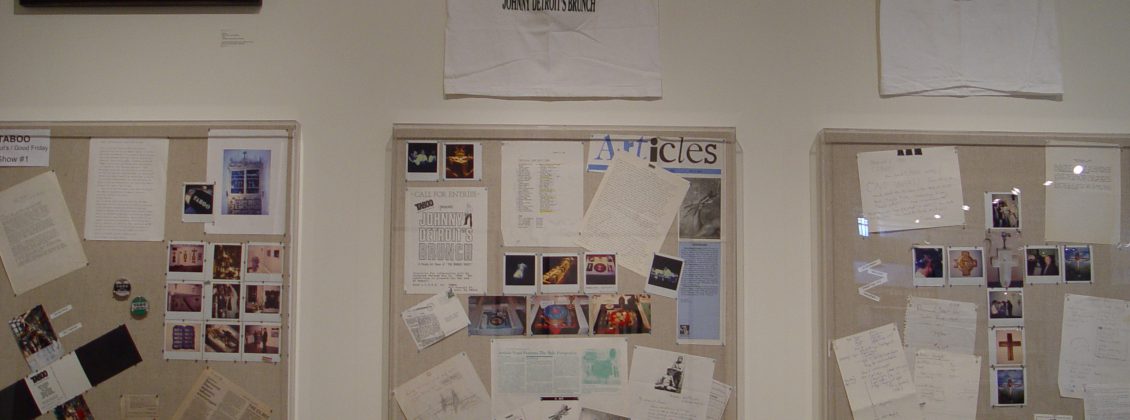
- This event has passed.

TABOO Remembered
10am - 5pm
“To the ancient Pacific island people who invented it, “taboo” meant too sacred or so evil that it can’t be touched. Thirty years ago “TABOO” captured the brash and uninhibited attitude of a group of Atlanta artists who had lost patience with the parochial attitudes of their contemporary art community. After meeting informally at Michael Venezia’s house to discuss art and deconstruct Atlanta’s provincialism, Larry Jens Anderson, King Thackston, Flounoy Holmes, Chick Lockerman, Venezia and a handful of others realized that they were each producing art that could not be shown in the Atlanta community. So, in 1987 they formed TABOO, an artist’s collective dedicated to undermining and exposing repressive and insular beliefs about art and culture through exhibitions and interventions. According to Anderson, the only surviving member of the group, “We always felt that we could put anything in our shows because the word TABOO gave us absolute license to go anywhere.”
The first TABOO exhibition in 1988 was inspired by the coincidence of Good Friday occurring in a leap year on “April Fools’ Day.” Each of the five artists above invited an additional artist to join them, and in an old bank building in the Castleberry District TABOO made its Atlanta debut. The centerpiece of its inaugural exhibition was the “Taboo Pole” or “Fetish Pole,” construction cylinders used for casting cement columns that were painted black with nails and hooks on which people could hang things. On the invitation guests were asked to bring a fetish for the Fetish Pole, transforming the passive exhibition into a participatory event. When the event was over, the artists found two comments in the guest book that they took to heart: “This isn’t so Taboo,” and “What will Taboo do next?” Anderson recalls “We thought ‘well, we can fix that’… and that’s when we became a group.”
TABOO’s next event was inspired by the tenth anniversary of Judy Chicago’s famous Dinner Party in 1989. Thackston had helped move the massive sculptural installation into the ballroom of Atlanta’s Fox Theater, and recalled how then Chicago insisted that all the men leave. Chicago had filled a room with vaginas; TABOO decided to fill a room with penises. The invitation read “Weenie Roast to discuss Johnny Detroit… Men Only.” Alluding to the Last Supper they had 12 figures seated on each side and 6 at the head of the 34 foot long table (there were six members of the group). Dr. Fallopian, Satan, Jesus and the Marquis de Sade were among the dinner guests. “Just like Chicago was not anti-male, this was not anti-female” Anderson explains. “Women protesters dropped their signs, and really liked the show.”
To finance “Johnny Detroit’s Brunch,” the group sold T-shirts that became the first examples of “Tabooware.” Often Tabooware T-shirts were created for interventions, not for sale: “TABOOLYMPICS: Greek Active Artists” (1994) for example, with “o”s transformed into Olympic rings, was a pun implying both athletic lifestyles and anal sex. At a grant-writing seminar at Nexus Contemporary Art Center in 1991, TABOO members wore T-shirts that read “White guys are ethnic too.”
TABOO collaboratively curated a total of thirteen shows, the last titled “Requiem MCMXCIX: Thirty Living Artists Eulogize the Dying Century” at Nexus in January of 1999, because the world was going to end in 2000, and they wanted to be talked about for an entire year. Decisions for every show were always by consensus, as Anderson explains “Nothing ever got into a TABOO show that all four of us didn’t agree on; no ‘maybe’ ever got in.”
Anderson curated “The Last TABOO” as one of the first historical shows at MOCA/GA (June 24 – July 9, 2005). Using the newly donated TABOO archives, the two part exhibition chronicled the history of the artists’ collaborative activities, and assessed what is TABOO today. The art that Anderson chose as TABOO today engaged a mixture of sex and violence, child abuse, race, sexual orientation and bodily functions.
The idea of empowerment was critically important to all of the artists of TABOO: “If it hadn’t been for a bunch of educated white gay men in the early 90s who were infected with AIDS” notes Anderson, activist interventions would not have occurred for many years. “White men feel empowered. If AIDS had first surfaced in a minority community, efforts to raise awareness would not have happened for a long time. If you believe you have power then you have power to change power relations.”
– Dinah McClintock, Professor of Art History, Kennesaw State University